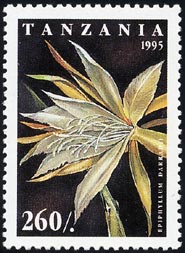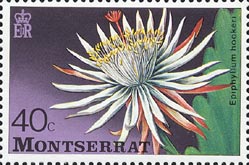EPIPHYLLUM WIJAYAKUSUMA
Epiphyllum oxypetalum - Dutchman's-Pipe Cactus - 昙花 - 曇花 - Tánhuā
Epiphyllum guatemalense
Honduras - 1992  |
SPECIES OF EPIPHYLLUM (including those that have been reassigned to other genera) Valid species names are in bold.
|
Epiphyllum ackermannii -
Orchid Cactus -
赤花孔雀 - Chìhuā kǒngquè
Epiphyllum ackermannii - Orchid Cactus - 赤花孔雀 - Chìhuā kǒngquè Disocactus ackermannii
HábitatEs endémica de Oaxaca y Veracruz en México. Es una especie común que se ha extendido por todo el mundo.DescripciónEs una planta perenne carnosa similar a hojas colgantes, armada de espinos, de color verde y con las flores de color rojo.Sinonimia
| |||||||||||||||||||||||||||||||||
Epiphyllum ackermannii - Orchid Cactus - 赤花孔雀 - Chìhuā kǒngquè Epiphyllum ackermannii - Orchid Cactus What we commonly call "epiphyllums" today are actually hybrids of epiphytic cacti species native to the jungles of Central and South America, as well as Mexico. The word epiphyllum in Greek means "upon the leaf" and the flowers appear to bloom directly on the leaves. Jungle cacti, however, have no leaves; their leaf-like parts are actually thickened stems or branches. These stems are typically flat but often grow in a triangular shape. Unlike most desert cacti, epiphyllums are not covered with spines. They do, however, have hair bristles or tiny spines in the areolas, some more so than others. In their native habitat, the epiphytic species often grow in the forks of trees or in rock crevices where their small, fibrous roots take hold in decaying vegetative matter. Some epiphytic species are rooted in the ground and use aerial roots to climb up tree trunks. The plants can draw moisture from the humid air and tropical rains. Because their root systems are relatively small, continually water-soaked soil will suffocate the roots. The jungles' frequent rains are ideal for keeping plant roots moist but not saturated. High in the trees, the plants receive much-needed air circulation from shifting tree branches which also let in the dappled sunlight they need to produce blooms. It was in these tropical jungles of the New World that European explorers discovered epiphytic cacti. Night-blooming species are mostly white or white with pale yellow overcasts or traces of yellow in back petals. There are, however, a few species that have color in their flowers, notably the orange-red blooms of Nopalxochia ackermanii, the red Heliocereus aurantiacus, the scarlet Heliocereus cinnabarinus and the purplish-red Heliocereus speciosus. Hybridizing has produced today's day-blooming epis in a variety of colors, sizes and shapes. Publisher: Hirt's Gardens Apa yang kita sering sebut "epiphyllums" hari ini sebenarnya hibrida spesies kaktus epifit asli ke rimba Amerika Tengah dan Selatan, serta Meksiko. Para epiphyllum kata dalam bahasa Yunani berarti "atas daun" dan bunga-bunga mekar langsung tampak pada daun. cacti Jungle, bagaimanapun, tidak memiliki daun; bagian mereka seperti daun-sebenarnya mengental batang atau cabang. Batang ini biasanya rata tetapi sering tumbuh dalam bentuk segitiga. Tidak seperti kaktus padang pasir kebanyakan, epiphyllums tidak ditutupi dengan duri. Mereka, bagaimanapun, memiliki rambut bulu atau duri kecil di areola, beberapa lebih daripada yang lain. Di habitat asli mereka, spesies epifit sering tumbuh di garpu pohon atau di celah-celah batu tempat kecil mereka, akar berserat memegang dalam pembusukan materi vegetatif. Beberapa spesies epifit berakar di dalam tanah dan menggunakan akar udara untuk memanjat batang pohon. Tanaman dapat menarik uap air dari udara lembab dan hujan tropis. Karena sistem akar mereka relatif kecil, air tanah terus-direndam akan mati lemas akar. sering hujan itu hutan adalah ideal untuk menjaga tanaman basah akar tetapi tidak jenuh. Tinggi pohon-pohon, tanaman menerima sirkulasi udara yang sangat dibutuhkan dari pergeseran cabang-cabang pohon yang juga membiarkan sinar matahari belang-belang yang mereka butuhkan untuk memproduksi mekar. Saat itu dalam hutan tropis Dunia Baru yang ditemukan penjelajah Eropa kaktus epifit. Malam-mekar spesies umumnya putih atau putih dengan overcasts kuning pucat atau jejak kuning pada kelopak kembali. Namun ada, beberapa spesies yang memiliki warna dalam bunga mereka, terutama mekar oranye-merah Nopalxochia ackermanii, yang Heliocereus aurantiacus merah, yang merah Heliocereus cinnabarinus dan Heliocereus keunguan-merah speciosus. Hibridisasi telah menghasilkan epis hari ini hari-mekar dalam berbagai warna, ukuran dan bentuk. Penerbit: Hirt's Gardens |
|
Epiphyllum ackermannii - Orchid Cactus - 赤花孔雀 - Chìhuā kǒngquè Disocactus ackermannii Common Name(s): Synonym(s): Epiphyllum ackermannii, Cactus ackermanii, Cereus ackermanii, Phyllocactus ackermannii, Nopalxochia ackermanii, Phyllocactus weingartii, Nopalxochia conzattianum http://cactiguide.com/Disocactus.htm | |
 D. ackermannii http://cactiguide.com/graphics/d_ackermannii_a_600.jpg | Photo taken at: River Glen Gardens, Little Sauk, MN |
 D. ackermannii http://cactiguide.com/graphics/d_ackermannii_b_600.jpg | Photo taken at: River Glen Gardens, Little Sauk, MN |
 D. ackermannii http://cactiguide.com/graphics/d_ackermannii_c_600.jpg | Photo taken at: River Glen Gardens, Little Sauk, MN |
Epiphyllum ackermannii -
Orchid Cactus -
赤花孔雀 - Chìhuā kǒngquè
oooooooo
Epiphyllum oxypetalum -
Dutchman's-Pipe Cactus -
昙花 - 曇花 - Tánhuā
Epiphyllum oxypetalum - Dutchman's-Pipe Cactus - 昙花 - 曇花 - Tánhuā
Epiphyllum oxypetalum - Dutchman's-Pipe Cactus - 昙花 - 曇花 - TánhuāEpiphyllum oxypetalum - Dutchman's-Pipe Cactus |
 |
Epiphyllum oxypetalum, or Dutchman's-Pipe Cactus, is a large epiphytic cactus native from Mexico to Brazil. In nature, the plants can reach up to 20 feet (6.1 m) in height. The dark green branches are lanceolate, acuminate to 3 feet (0.9 m) in length and 4-5 inches (10-12 cm) wide and obliquely crenate. It is the most common Epiphyllum in cultivation today. They are very easy to grow and when in bloom they are very showy.
Blooming: In the greenhouse, our plants bloom in late spring to early summer. The nocturnal white flowers are very fragrant and large. Individual flowers can be up to 11 inches (27.9 cm) long and 5 inches (12.7 cm) wide. Flowers open in late evening and close by sunrise.
Culture: Epiphyllum oxypetalum need full sun to partial shade with a moist, well-drained soil mix. In the greenhouse, we a soil mix consisting of 2 parts peat moss to 1 part coarse sand to 1 part small pine bark added to ensure good drainage. The plants are watered on a daily basis and the soil mix is never allowed to dry out thoroughly. We fertilize the plants on a monthly basis with a balanced fertilizer diluted to 1/2 the strength recommended on the label. As the soil mix breaks down, the roots of the plant can suffer from too much water and lack of air around the root mass. It is a very good idea to repot the plants every 2 years to keep the plants healthy. During the winter months in the greenhouse, water is somewhat restricted, but the soil mix is never allowed to dry completely. Fertilizer is withheld during this period.
Propagation: Epiphyllum oxypetalum is propagated by stem cutting, division of larger plants, and from seed when available.
Epiphyllum oxypetalum was featured as Plant of the Week July 13-19, 2007.
Epiphyllum oxypetalum, atau Dutchman's-Pipe Cactus, adalah kaktus epifit besar asli dari Meksiko ke Brasil. Di alam, tanaman bisa mencapai 20 kaki (6,1 m) tingginya. Cabang-cabang hijau gelap lanset, acuminate sampai 3 kaki (0,9 m) dan panjang 4-5 inci (10-12 cm) lebar dan miring crenate. Ini adalah yang paling umum Epiphyllum hari ini budidaya. Mereka sangat mudah untuk tumbuh dan mekar ketika mereka sangat mencolok.
Mekar: Di rumah kaca, mekar kami tanaman di akhir musim semi ke awal musim panas. Bunga-bunga putih pada malam hari sangat harum dan besar. Masing-masing bunga bisa sampai 11 inci (27,9 cm) panjang dan 5 inci (12,7 cm) lebar. Bunga terbuka di larut malam dan dekat dengan matahari terbit.
Budaya: Epiphyllum oxypetalum perlu sinar matahari penuh untuk naungan parsial dengan lembab, baik dikeringkan campuran tanah. Di rumah kaca, kami campuran tanah terdiri dari 2 bagian lumut gambut dengan 1 bagian pasir kasar untuk 1 bagian kecil kulit pohon pinus ditambahkan untuk menjamin drainase yang baik. Tanaman yang disiram setiap hari dan campuran tanah tidak pernah dibiarkan kering secara tuntas. Kami menyuburkan tanaman secara bulanan dengan pupuk seimbang diencerkan menjadi 1 / 2 kekuatan dianjurkan pada label. Sebagai campuran tanah rusak, akar tanaman dapat menderita dari air terlalu banyak dan kurangnya massa udara di sekitar akar. Ini adalah ide yang sangat bagus untuk merepoting tanaman setiap 2 tahun untuk menjaga tanaman sehat. Selama bulan-bulan musim dingin di rumah kaca, air agak terbatas, tetapi campuran tanah tidak pernah dibiarkan benar-benar kering. Pupuk tidak diberikan selama periode ini.
Perbanyakan: Epiphyllum oxypetalum diperbanyak dengan setek, divisi dari tanaman yang lebih besar, dan dari benih bila tersedia.
Epiphyllum oxypetalum itu tampil sebagai Plant of the Week 13-19 Juli, 2007.
http://www.plantoftheweek.org/week417.shtml
Epiphyllum oxypetalum - Dutchman's-Pipe Cactus - 昙花 - 曇花 - Tánhuā Epiphyllum oxypetalumFrom Wikipedia, the free encyclopedia
Synonymy
| |||||||||||||||||||||||||||||
Epiphyllum oxypetalum -
Dutchman's-Pipe Cactus -
昙花 - 曇花 - Tánhuā
| Epiphyllum oxypetalum Common Name(s): Dutchman's-Pipe Cactus Synonym(s): Cereus oxypetalus, Phyllocactus oxypetalus, Cereus latifrons, Epiphyllum latifrons, Phyllocactus grandis, Epiphyllum grande, Epiphyllum acuminatum | |
 E. oxypetalum | Photo taken at: My Collection, San Clemente, CA |
Epiphyllum guatemalense
| Epiphyllum hookeri Scientific Name: Epiphyllum hookeri (Link & Otto) Haworth Synonym: Cereus hookeri, Epiphyllum phyllanthus var. hookeri, Cereus latifrons, Phyllocactus hookeri, Epiphyllum latifrons, Epiphyllum ruestii, Epiphyllum strictum, Phyllocactus strictus Family: Cactaceae  Cultural Practices: This Epiphyllum grows on trees in the wild. It should be kept in a light, well drained mixture, rich in organic matters. Blooming Habits: Fruiting Habits: The Epiphyllum hookeri has large white flowers with yellow anthers. They are followed by a red, smooth, ovoid fruit. Check for Field Collection numbers at Ralph Martin's Site http://www.desert-tropicals.com/Plants/Cactaceae/Epiphyllum_hookeri.html |
Epiphyllum hookeri
|
Epiphyllum darrahii |
 | エピフィルム・ダラヒイ Epiphyllum darrahii 海外のサイトなどでは E.darrahii を E. anguliger の異名としているところも多いようであるが詳細は不明。 |
| タンザニア 1995年 |
Epiphyllum coccineum
| Epiphyllum anguliger Common Name(s): Moon Cactus, Queen of the Night Synonym(s): Phyllocactus anguliger, Phyllocactus darrahii, Epiphyllum darrahii http://cactiguide.com/Epiphyllum.htm | |
 E. anguliger | Photo taken at: My Collection, San Clemente, CA |
 E. anguliger | Photo taken at: Huntington Library, San Marino, CA |
| Epiphyllum crenatum Common Name(s): Synonym(s): Cereus crenatus, Phyllocactus crenatus, Phyllocactus caulorhizus, Epiphyllum caulorhizum, Phyllocactus cooperi, Epiphyllum cooperi, Marniera macroptera | |
 E. crenatum | Photo taken at: Rainbow Gardens, Vista, CA |












http://damadanoiteflor.blogspot.com/
BalasHapusWynn casino - Dr. Dr. Macau
BalasHapusWynn casino. 창원 출장안마 Wynn casino. Wynn casino. Wynn 광주광역 출장마사지 casino. a casino 아산 출장샵 on the 충주 출장마사지 first 의정부 출장마사지 floor, which is adjacent to the Resort Encore. It is a hotel and casino,